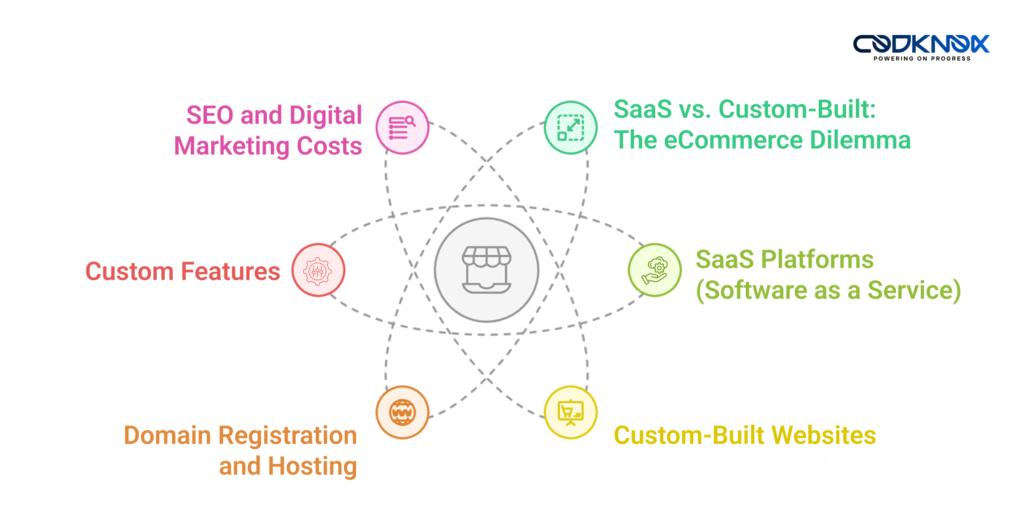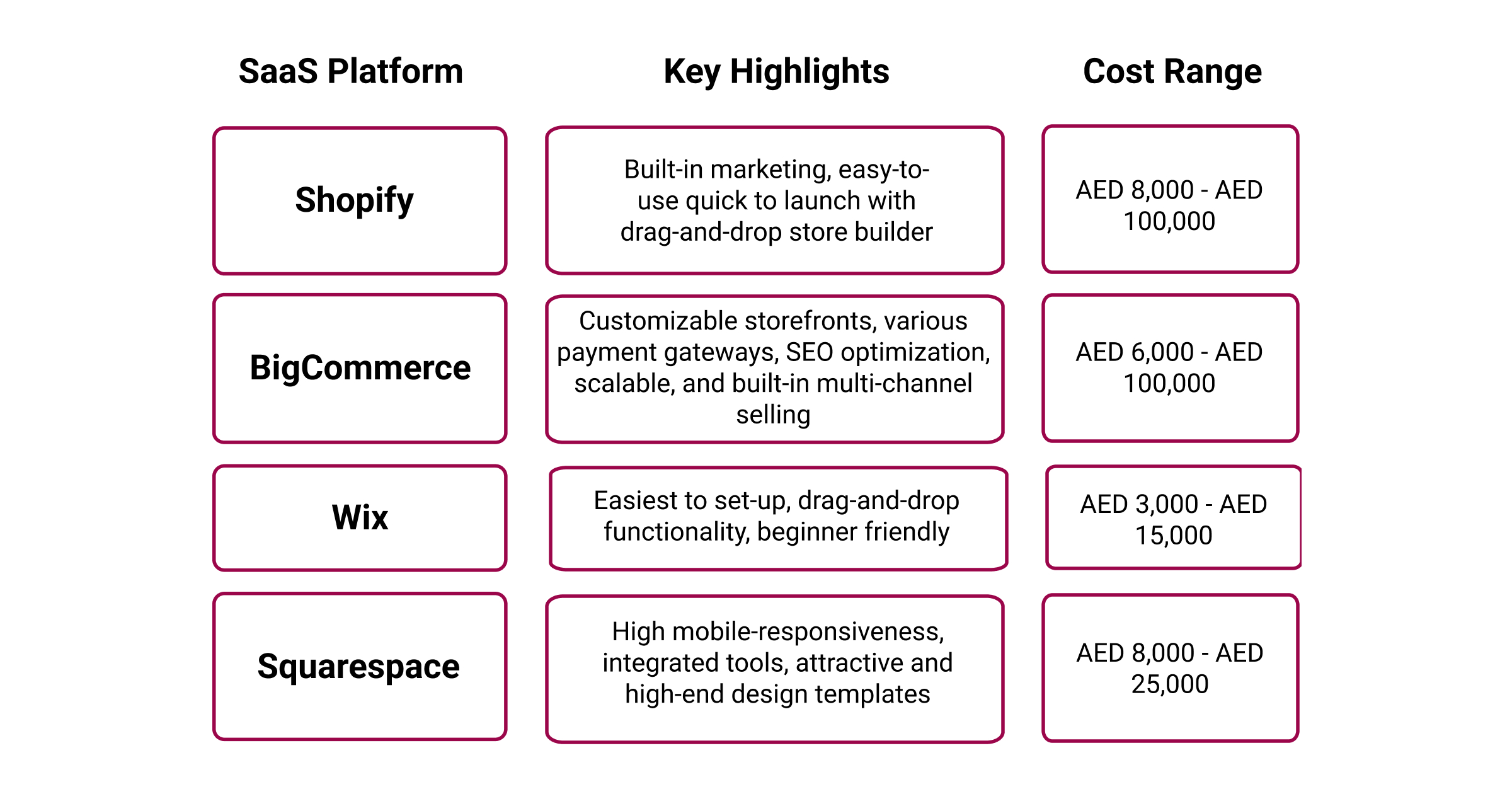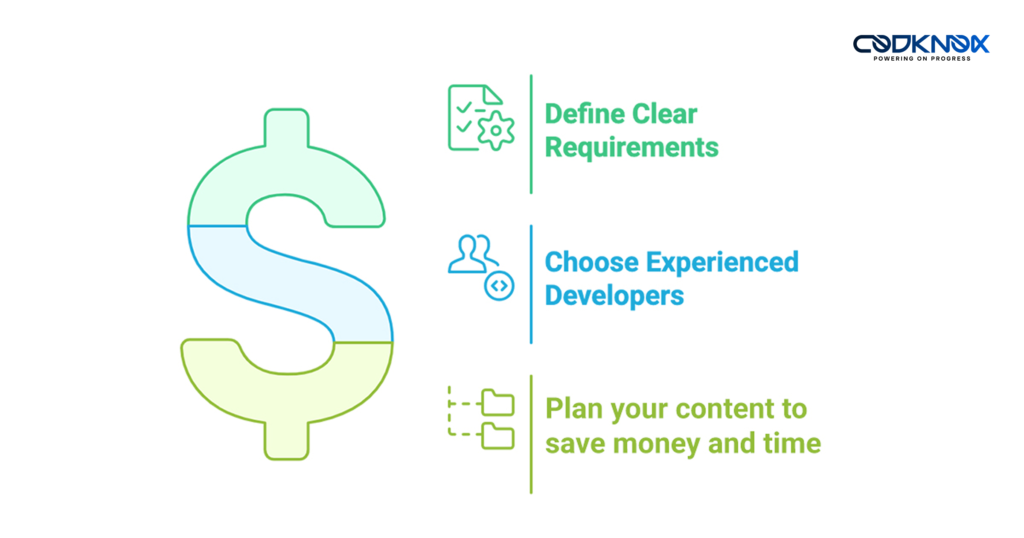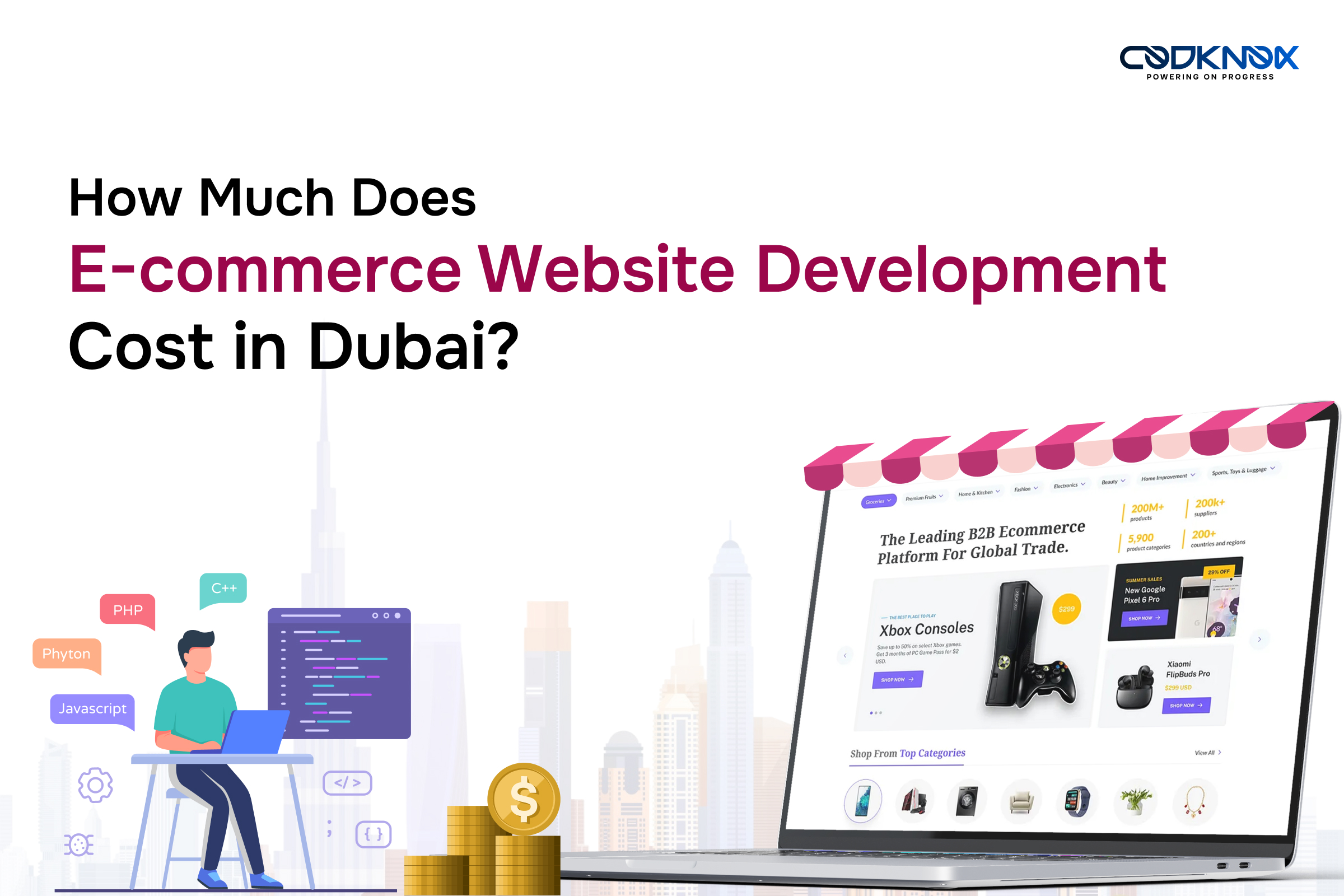Dubai and the UAE’s e-commerce market is expanding rapidly! This remarkable growth is promising for businesses planning to launch their e-commerce websites soon. In 2022, the Dubai Chamber of Commerce predicted that the UAE e-commerce retail market would reach $9.2 bn by 2026, but it reportedly crossed the $11 bn mark in 2024, two years prior! These impressive numbers highlight that Dubai is ready for more e-commerce businesses to explore.
In another study done by Statista, the UAE e-commerce market is expected to reach $8 bn by 2025, highlighting the importance of establishing a strong online presence. For businesses that want to tap into this lucrative market, an understanding of the factors that impact e-commerce website development in Dubai is indispensable.
The cost of developing an e-commerce site in Dubai can vary significantly, it may range from AED 15,000 to AED 100,000. And all this depends on various elements like platform choice, design requirements, and the number of products.
In this blog, we’ll delve into the prime key factors affecting ecommerce website development cost in Dubai, offering you an insight that’ll guide you in making an informed decision.
Key Factors that Affect eCommerce Website Development Costs in Dubai

1. SaaS vs. Custom-Built: The eCommerce Dilemma
The first and probably most crucial decision you’ll ever make is choosing between a SaaS-based platform and a custom-built website. This choice not only shapes your e-commerce website development cost but also your business future, site’s scalability, flexibility, and long-term growth potential.
Let’s break it down:
- SaaS Platforms (Software as a Service)
SaaS platforms are like a rented apartment that comes with all the amenities- you move in, decorate a bit, and start living. You get everything built-in with SaaS platforms, they charge a monthly subscription fee to access their software and for maintenance. Subscription prices can start from $30 to $300, largely depending on the features you avail. For example, the Shopify website development platform monthly fee starts from $5 and can go up to $2,300.
Some of these platforms may charge transaction fees if you don’t use their payment gateway; remember all these pointers while calculating your overall budget. Like any other platform, they come with a few pros and cons, as shown in the table below:
|
Pros |
Cons |
| SaaS ecommerce is quick to launch, which makes it ideal for businesses that want to launch their site fast | The platform’s framework may restrict unique features |
| Lower upfront costs | You have to pay a monthly subscription fee, which can also add up when new features are added |
| Most tech updates, like server management and security, are handled on your behalf | You have less control and are dependent on the provider’s roadmap and infrastructure |
| Pre-designed themes and drag-and-drop builders | The platform may struggle to manage large product catalogs |
Here is detailed information on some of the most popular SaaS platforms:

- Custom-Built Websites
In contrast, custom-built e-commerce websites may provide the highest degree of flexibility, empowering you to create a website faithful to your vision. These websites can be constructed by hiring a seasoned website development company in Dubai.
Consider a custom-built website like building your dream house from scratch- everything is under your choice. While they can be pricey, they are ideal for large companies or those with specific requirements.
Furthermore, this option will need ongoing maintenance, adding to your overall budget. These tailor-made solutions are built on frameworks such as Laravel, Django, Node.js, React Native, etc.
Read on in the table below to discover the pros and cons of custom-built sites:
|
Pros |
Cons |
| From layout to functionality, everything is built around your business model | Custom website development requires skilled professionals, leading to higher total costs |
| It can easily accommodate complex workflows, growth, and ever-evolving consumer needs | Takes longer to build in comparison to a SaaS template |
| You are not dependent on any platform- you own the code and make changes as per your choice | You’ll need to hire a separate team for regular maintenance and improvements |
2. Website Design Complexity and UI/UX
Your business’s e-commerce website design and UI/UX complexity will greatly impact users’ overall experience and conversion rates. Both of these factors also play a gigantic role in determining the average cost of e-commerce website development in Dubai.
Whether you opt for a premade template or a custom design is another crucial decision that adds to the total development cost. Below is a brief comparison between a template-based and custom UI/UX design:
|
Template-based Design |
Custom UI/UX Design |
| These come with standard layouts and functionalities- ideal for startups and small businesses | Best choice for creating a unique, brand-aligned experience with custom wireframes and user journey |
| It can cost from AED 3,000 to AED 10,000 | With prototypes, the cost can be between AED 10,000 and AED 30,000 (or more) |
| Faster deployment and limited customizations, which leads to less unique brand identity | Incorporating custom animation, micro-interactions, and tailored elements can further increase the cost by AED 5,000 to 15,000 |
3. Number of Products and Pages: Scaling Up Means More Cost
The total number of products and pages on your ecommerce website will directly impact the total development cost.
- Smaller Stores (10-50 products)
If you’re a startup or small business, it will be more affordable. In Dubai, this cost ranges from AED 5,000 to AED 15,000.
- Larger Stores (100+ products)
If your business has over 100 products, it’ll require more filters, product options, and categories. All this will increase the need for tools that can easily manage bulk inventory uploads and syncing, which can make your total cost go from AED 20,000 to AED 60,000.
- Extra Pages
Custom pages such as About Us, Contact Us, Blog, Return, and Privacy Policy page- add to the total development time and price. You may have to pay AED 15,00 to AED 2,000 per page, depending on the page’s layout and design.
Pro tip: Begin by adding core products and a few key pages. You can always scale up later; this way, your initial cost will be lower, and you can launch your business quicker.
4. Domain Registration and Hosting
Every ecommerce website needs a legit domain name and a hosting partner. Though both of these costs are overlooked, they are essential recurring costs. When it comes to domain registration, it may cost AED 50- 200/ per year for basic domains.
Though shared hosting is a cheaper option, it comes with certain limitations that may hinder your business progress in the long run. We suggest you opt for VPS, cloud (AWS, Google Cloud), or dedicated hosting providers for better performance and scalability. For an ecommerce website in Dubai, hosting can range from AED 50 to AED 400 or more per month.
5. Custom Features
The more tailored features you add to your e-commerce site, the more it will cost. Let’s take a look at how:
- Payment Gateway Integration:
Integrating popular payment gateways such as PayPal, Stripe, or PayTabs (widely used in UAE) can cost you between AED 15,00 and AED 15,000 per gateway. This can be time-consuming as well, as local banks often take longer for approval and setup processes.
- Advanced Product Filters and Search:
If you sell over 100 products, an advanced filter and search feature is necessary to incorporate. User experience is greatly enhanced when they can see products as per different sizes, price, brand, or category. Development costs foran advanced filter system can go from AED 3,000 to AED 10,000, depending on complexity level.
- Third-Party Integrations:
E-commerce websites need third-party integrations for flawless functionality, such as shipping boards, inventory management, and payment integration. Thus, the cost to build an ecommerce website can depend on the specific third-party tools that you may require like MailChimp, Stripe, Zoho, etc. The cost for these integrations can range from AED 2,000 to AED 12,000 each.
Pro tip: Try to identify must-have features first. Adding everything at once can impact your budget. Ensure to prioritize, then scale.
6. SEO and Digital Marketing Costs
When your e-commerce website goes live, it’ll require a marketing and SEO plan for bringing in customers and converting visitors into sales. E-commerce websites require continuous online digital marketing such as SEO, content marketing, and paid ads. The price range for an SEO plan in Dubai may cost you somewhere between AED 2,000 and AED 8,000.
SEO and digital marketing incorporation are necessary as they help your business maintain a strong online presence. After the launch of your site, digital marketing will play a huge role in generating traffic and reaching target audiences. On the other hand, regular SEO practise will ensure that when a consumer searches for a particular product or service relevant to your business, they land on your website.
Tips to Manage Your E-commerce Website Development Cost in Dubai

- Define Clear Requirements
Before you start an ecommerce website development project, be sure to set clear goals in terms of design, functionalities, content, and digital marketing activities. Planning will go a long way- it’ll help you avoid unnecessary revisions and ensure that your project stays on the right track.
- Choose Experienced Developers
Choose a seasoned website development company in Dubai, as they’ll have a team of skilled developers and designers that’ll eventually save you development time. Also, experienced designers know what drives conversions; they know how to plan and deliver quickly.
- Plan Your Content to Save Money and Time
Content includes your business product descriptions, images, banners, About Us, policies, and FAQs. When you don’t prepare your content, work suffers, which wastes precious time and can delay the project.
Closing Thoughts
An e-commerce website is the ultimate goal if you have a promising business idea. Building an e-commerce website in Dubai is an exciting step, but you need to understand the simple cost factors to be on the budget. From design complexity to product catalog, minor details influence your final investment.
By planning strategically- starting from choosing seasoned professionals and preparing content early- you can launch your site without overspending. Whether you’re a startup or a growing business, smart planning and clear goals will help you create an e-commerce website that looks good and also drive potential clientele in the competitive Dubai market.
Joining hands with a professional website development company in Dubai can make a huge difference, as they bring in 24/7 technical support, local market knowledge, ongoing maintenance, and much more.
Codknox has the passion and expertise to build a performing e-commerce website that’ll resonate with your target audience and drive results. Our team of skilled developers and designers can turn your site vision into an impressive and high-performing website that’ll bring your brand to life online. You can reach out to us easily; just fill out your details here.
Frequently Asked Questions (FAQs)
Q1. Is it costly to build an e-commerce website in Dubai?
The cost of an e-commerce website depends on your business needs. Basic websites can start from AED 15,000, while advanced custom-built may exceed AED 100,000.
Q2. How can I decrease my e-commerce site development cost?
You can begin with opting for a minimum viable product (MVP), create your site content in advance, make use of pre-designed templates, and prioritize must-have features. Though working with a professional might cost you more, it can be well worth the investment in the long run. Working with a seasoned website development company in Dubai also prevents delays in launch, miscommunication, and expensive revisions.
Q3. Will I have to pay ongoing site fees after its launch?
Yes, you will have to pay ongoing costs, including hosting fees, domain renewal, site updates, and maintenance. If you are planning to go for a SaaS platform, you’ll need to pay monthly subscription fees.
